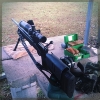Nature Boy
Member
- Joined
- Apr 21, 2015
- Messages
- 8,256
I had a great .5 MOA load that used federal 210M primers but since I can't find them I'm trying to find an equivalent with a CCI BR primer. I also broke out some new, never fired, LC 15 brass, which I ran through the sizer. I decided to use 10 round groups and shot them round robin style. Interested to hear what the results say to you guys.
I decided to stay in the range of the previous load and work off of that in 0.3g increments, up and down.
I used:
168 AMAX
H4895
OAL 2.895-to the lands
5 groups, 38.7 - 39.9

I note that some of the groups had what looks like smaller groups within, which made me think I had some parallax that I hadn't fully dialed out, but I kept checking and pretty sure that wasn't the case. Group A has a pronounced vertical stringing that the other groups didn't.
Again. Curious what it says to the experts here. 50 rounds for load development can get expensive, but it was interesting and if I can learn something then it's worth it.
I decided to stay in the range of the previous load and work off of that in 0.3g increments, up and down.
I used:
168 AMAX
H4895
OAL 2.895-to the lands
5 groups, 38.7 - 39.9

I note that some of the groups had what looks like smaller groups within, which made me think I had some parallax that I hadn't fully dialed out, but I kept checking and pretty sure that wasn't the case. Group A has a pronounced vertical stringing that the other groups didn't.
Again. Curious what it says to the experts here. 50 rounds for load development can get expensive, but it was interesting and if I can learn something then it's worth it.




